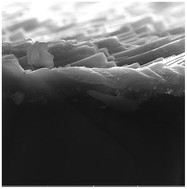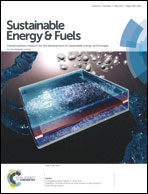Effect of anodization time on photovoltaic properties of nanoporous silicon based solar cells†
Abstract
This study describes the fabrication procedure of hybrid porous silicon-based solar cells. Porous silicon was synthesized by electrochemical anodization (EA) of polysilicon under an etching time of 6, 8, and 10 min, using HF/EtOH solution. The fabricated template was employed as an active substrate to undertake an n-type semiconductor. TiO2 nanoparticles (NPs), as emitter, were immobilized over the porous substrate using an electrophoretic deposition (EPD) method. Indium-tin oxide (ITO), as the front electrode, was sputtered to extract the carriers using a DC magnetron sputtering technique. The surface morphology was studied by observing the FESEM images. Optical properties of the proposed system were investigated by reflection and absorption spectra. Finally, photovoltaic measurements of the fabricated cells were studied for different samples. The measurements were accomplished under AM 1.5 illumination using a solar simulator. It was demonstrated that the 6 min anodized sample showed the highest performance; the efficiency was 1.57 and 2.73 times higher than that of the 8 and 10 min samples, respectively. The preferential 6 min sample showed lowest reflection as well as a more appropriate band gap. The competitive efficiency could be attributed to the coherent and compact p–n junctions as well as to the qualified immobilization of the hole-barrier layer (metal oxide).



 Please wait while we load your content...
Please wait while we load your content...